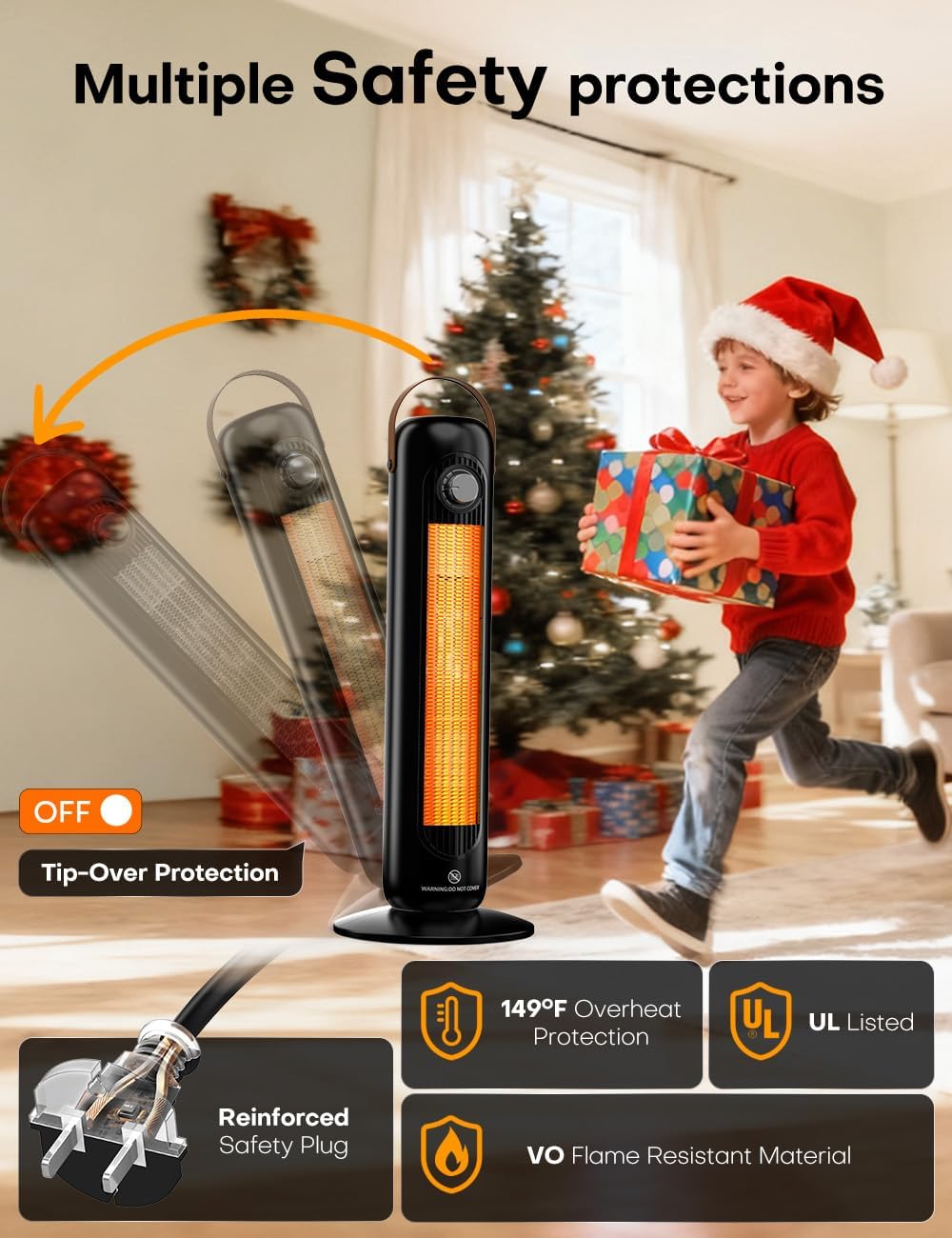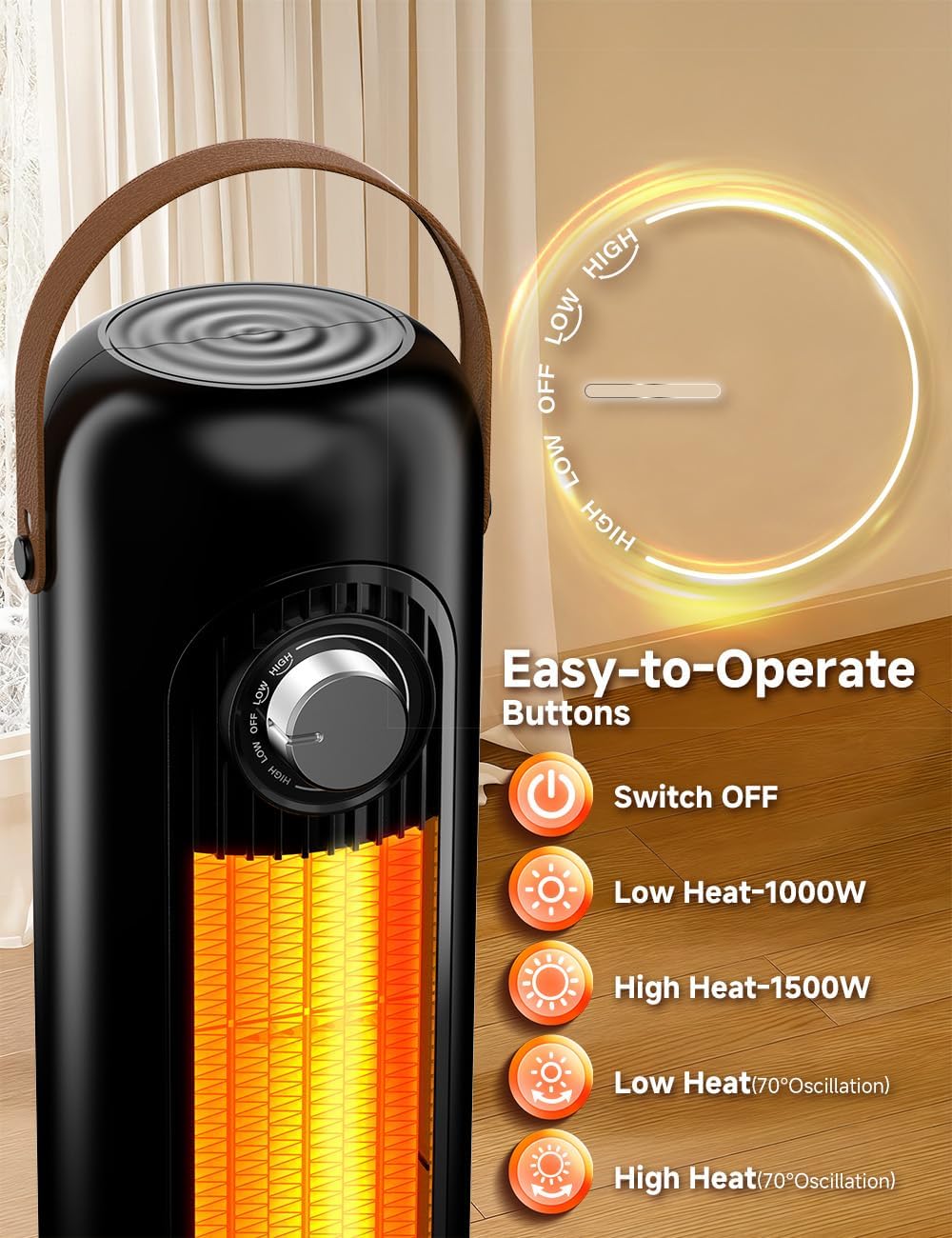Winter hit hard last year. My central heating system struggled to keep my 1,200 square foot apartment comfortable, and I watched my utility bills climb higher each month. The problem? My aging HVAC system was working overtime to heat rooms I barely used while leaving my living room and bedroom perpetually chilly. That’s when I discovered the game-changing solution: a quality tower space heater that transformed my winter comfort while actually reducing my energy costs. Let me share what I learned through trial, error, and lots of research about choosing the right supplemental heating solution.

Why Tower Space Heaters Are Having a Moment Right Now
We’re experiencing a supplemental heating revolution, and tower space heaters are leading the charge. Here’s why they’ve become essential for modern homes:
Rising energy costs have made zone heating—heating only the rooms you’re using—a practical necessity rather than just a nice option. Traditional central heating systems waste enormous amounts of energy warming unused spaces. Meanwhile, older portable heaters were bulky, inefficient, and frankly, kind of scary from a safety perspective.
The Tower Design Advantage
The vertical tower design changed everything for me. Unlike those squat, space-hogging heaters your parents used, modern tower space heaters offer a sleek footprint that fits anywhere. My 25-inch tall unit occupies less than one square foot of floor space while delivering powerful, room-filling warmth.
Here’s what makes the tower design so brilliant:
- Space efficiency: Fits into corners, beside furniture, or under desks
- Better air circulation: Height enables superior heat distribution
- Aesthetic appeal: Looks like intentional decor, not clunky equipment
- Stability: Lower center of gravity compared to width reduces tip risk
I initially worried about finding space in my already-crowded living room. Turns out, the slim tower profile slipped perfectly beside my couch where a traditional heater never would have fit.
Understanding PTC Ceramic Heating Technology: Why It Matters

Let’s talk about what actually warms you. Not all heating elements are created equal, and understanding the difference will help you make a smarter purchase.
PTC Ceramic: The Superior Heating Element
PTC stands for “Positive Temperature Coefficient,” which sounds technical but delivers practical magic. Here’s what happens inside a quality tower space heater with PTC ceramic technology:
The ceramic element heats rapidly—we’re talking about reaching optimal temperature in literally one second. Unlike old-school coil heaters that take several minutes to warm up, PTC technology delivers instant gratification. When I walk into my cold home office on a winter morning, I’m feeling warmth within seconds of flipping the switch.
The efficiency breakthrough: PTC ceramic maintains a stable temperature automatically. As the element heats, its electrical resistance increases, naturally limiting how hot it gets. This self-regulating property means consistent warmth without the fire hazard of overheating elements.
In practical terms? My tower space heater delivers a 92.5% increase in heating efficiency compared to my old coil heater. That translates to lower electricity usage for the same comfort level—something my utility bill confirms month after month.
The 1500W Sweet Spot
You’ll notice most premium tower space heaters max out at 1500 watts. That’s not arbitrary—it’s the perfect balance of heating power and standard electrical compatibility.
A 1500W heater can:
- Operate on standard 15-amp household circuits without tripping breakers
- Heat rooms up to 350 square feet effectively
- Deliver powerful warmth without requiring dedicated electrical work
- Maintain safe operation without overloading your home’s electrical system
My living room measures about 320 square feet. The 1500W output brings it from uncomfortably cold to cozy warm in roughly 15 minutes—faster if I use the oscillation feature.
The Four Heating Modes: Customizing Comfort for Every Situation
One feature I didn’t know I needed until I had it? Multiple heating modes. The four-mode system in a quality tower space heater provides surprising versatility.
Low Mode (1000W): The Energy Saver
I use this mode more than any other. When I’m working from home and just need to take the edge off the chill, low mode provides gentle, consistent warmth without cranking up electricity usage.
Perfect scenarios for low mode:
- Maintaining comfort in moderately cool rooms (60-65°F)
- Overnight bedroom heating for consistent sleep temperature
- Extended use during milder winter days
- Supplementing weak central heating rather than replacing it
The energy savings here are real. Running at 1000W instead of 1500W reduces electricity consumption by 33%. Over a winter season of daily use, that difference adds up significantly.

High Mode (1500W): Maximum Power
Cold mornings and particularly frigid days call for maximum heating power. High mode on my tower space heater delivers rapid temperature increases when you need serious warmth fast.
I reserve high mode for:
- Initial room heating when temperatures are quite low
- Larger spaces that need aggressive warming
- Particularly cold days when low mode won’t cut it
- Times when I need to heat my space quickly before guests arrive
Pro tip: I start with high mode to bring the room to comfortable temperature, then switch to low mode to maintain it. This approach balances speed with efficiency.
Oscillation Modes: The Coverage Game-Changer
Here’s where things get interesting. Both low and high modes can operate with 70-degree oscillation, fundamentally changing how the heater performs.
Without oscillation: Direct, concentrated heat in one direction. Great for personal warming or targeting specific seating areas.
With oscillation: Even heat distribution throughout the room. The tower space heater slowly rotates through a 70-degree arc, spreading warmth across a much wider area.
The oscillation feature solved my biggest frustration with previous heaters—uneven room temperatures. Instead of one warm spot near the heater and cold zones everywhere else, my entire 350-square-foot living room reaches comfortable temperature.
The 70-degree sweep isn’t random either. That specific angle provides optimal coverage for most room layouts without over-rotating to areas that don’t benefit (like pointing at walls or windows where heat escapes).

Safety Features: Why This Matters More Than You Think
I’ll be honest—my first space heater purchase twenty years ago was based entirely on price. I bought the cheapest option available and used it nervously, worried about fire risks. That anxiety ruined the comfort the heater should have provided.
Modern tower space heaters with comprehensive safety systems changed everything. Now I use mine confidently, even running it overnight in my bedroom.
Tip-Over Protection: The Peace-of-Mind Feature
Life happens. Pets zoom past. Kids play energetically. You accidentally kick the heater while walking by in the dark. With older heaters, any of these scenarios could spell disaster.
Tip-over protection works through a sensor that detects when the heater exceeds a 45-degree angle from vertical. The moment that threshold is crossed, power cuts instantly—no flames, no scorched carpet, no emergency.
I tested this feature deliberately (don’t judge me—I needed to know it worked). I tilted my tower space heater beyond 45 degrees, and power shut off immediately. Within one second. That response time eliminates the danger window almost entirely.
Real-world scenario: My friend’s dog knocked over her old heater while playing. It fell onto a blanket, heating element still glowing hot. She smelled burning fabric within minutes. With modern tip-over protection? The heater would have shut off before even touching the blanket.
Overheating Protection: The Hidden Guardian
Even during normal operation, things can go wrong. Blocked airflow, component failure, or unusual environmental conditions could cause dangerous temperature spikes.
Overheating protection monitors internal temperature continuously. If the sensor detects temperatures exceeding 149°F—well above safe operating levels—the heating element shuts down automatically.
This safety feature operates independently of the thermostat or user controls. Even if the heater malfunctions or experiences unusual conditions, this failsafe prevents fire risk.
The Safety Grille: Physical Barrier Protection
Touch a traditional space heater’s metal grille during operation, and you’re getting burned. No question. I learned this lesson the hard way as a teenager.
The safety grille on a quality tower space heater prevents direct contact with heating elements entirely. The spacing allows airflow while ensuring fingers—especially small, curious ones—can’t reach dangerous components.
For pet owners and parents: This feature alone justifies the investment. My nephew can play near my heater without my constant anxiety about burns. My cat can walk past without singeing whiskers. That peace of mind is priceless.

UL Certification: The Stamp That Matters
Anyone can claim their product is “safe.” UL certification proves it through independent testing. When you see UL certification on a tower space heater, you’re looking at a product that passed rigorous safety standards covering:
- Electrical component safety and insulation
- Fire and heat resistance of materials
- Proper grounding and electrical protection
- Stability and tip-over prevention
- Accurate safety feature functioning
I only buy UL-certified heating products. Period. The testing investment by manufacturers demonstrates they’re serious about safety, not just checking boxes.
Quiet Operation: The Feature You’ll Appreciate Daily
Here’s something nobody mentions in their initial heater shopping research: noise levels. Then you bring home a heater that sounds like a jet engine, and suddenly you realize how much this matters.
The 30dB Difference
A quality tower space heater operates at approximately 30 decibels. To put that in perspective:
- 30dB: Whisper, quiet library, rustling leaves
- 40dB: Quiet residential area, soft music
- 50dB: Normal conversation, dishwasher
- 60dB: Office environment, loud conversation
My heater runs quieter than my refrigerator. Quieter than my laptop fan. I can work, sleep, or watch TV without competing with heater noise.
The Technology Behind the Silence
Upgraded DC motors and precision-engineered impellers make modern quiet operation possible. Traditional AC motors created vibration and mechanical noise. DC motors run smoother, with fewer moving parts generating friction and sound.
The impeller—the fan component that moves air—matters enormously. Cheap heaters use imbalanced, poorly designed impellers that create turbulent airflow and noise. Quality tower space heaters feature aerodynamically optimized impellers that move air efficiently with minimal sound generation.
Real-world impact: I run my heater overnight in my bedroom throughout winter. It maintains comfortable temperature without disrupting sleep. Before discovering quiet models, nighttime heating meant choosing between comfort and sleep quality. Now I have both.

Who Benefits Most from Tower Space Heaters?
Not everyone needs a tower space heater. But if you fall into these categories, you’ll wonder how you lived without one.
Apartment Dwellers and Renters
You can’t modify your heating system, upgrade insulation, or install zone controls when you’re renting. A portable tower space heater provides comfort solutions without permanent modifications or landlord permissions.
I spent years in apartments with terrible heating. One place had baseboard heaters that made my bedroom unbearably hot while leaving my living room freezing. A tower heater let me turn down the inefficient baseboard and use supplemental heating exactly where needed.
Bonus advantage: When you move, your heater moves with you. Unlike your rent money or utility bill payments, this investment follows you to every future home.
Home Office Workers
The rise of remote work created a heating dilemma: do you heat your entire home all day for the sake of one room? That’s wildly inefficient.
A tower space heater in your home office provides focused comfort without wasting energy on unused spaces. I close my office door, run my heater, and maintain perfect working temperature while keeping my thermostat low everywhere else.
Productivity impact: I’m more focused, comfortable, and efficient when I’m not distracted by cold feet and chilly air. The heater paid for itself within two months through increased work quality and reduced procrastination.

People with Uneven Home Heating
Central heating systems create hot and cold zones. Heat rises, so upper floors run hot while basements stay cold. Rooms far from the furnace receive less heat than those nearby. South-facing rooms with sun exposure need less heating than north-facing spaces.
My apartment’s bedroom sits on an exterior corner—two walls facing outside, lots of windows, naturally cold. My living room, conversely, sits interior and stays warmer naturally. One thermostat setting can’t serve both spaces well.
The tower space heater solves this by providing targeted supplemental heating where central systems underperform. Now both rooms maintain comfortable temperatures without overheating or overcooling either space.
Energy-Conscious Households
If you care about environmental impact and utility costs, zone heating with a tower space heater dramatically reduces waste.
Consider the math: Heating a 1,500 square foot home to 70°F requires substantial energy. But you only occupy maybe 300-400 square feet at any given time. You’re paying to heat 75-80% unused space constantly.
Instead, keep your central heat at 62°F (enough to prevent pipe freezing and maintain baseline comfort), then use a tower space heater in occupied rooms. Your furnace runs far less frequently, and the efficient heater handles the temperature boost in your immediate space.
My real numbers: My monthly heating costs dropped from $180-220 to $120-140 after implementing this strategy. That’s $60-80 monthly savings, or $240-320 over a typical four-month heating season. The heater paid for itself within two winters.
Families with Varying Temperature Preferences
Does your partner run hot while you’re always cold? Do your kids keep their rooms at different temperatures? Family temperature battles waste energy and create household friction.
Multiple tower space heaters let everyone customize their personal space temperature without affecting others. My partner keeps our bedroom at 68°F with no supplemental heat. I run a heater in my office to maintain 72°F. Everyone’s happy, and we’re not heating unused space.
Size and Portability: The Practical Everyday Advantages
One reason I love my tower space heater? I can move it anywhere within seconds.
The Perfect Dimensions
At approximately 9.25 x 9.25 x 23.6 inches, the tower footprint fits virtually anywhere. That 25-inch height provides effective air circulation while remaining stable and unobtrusive.
Weight matters too. At just 4.4 pounds, my heater weighs less than most laptops. The built-in carry handle means I can grab it with one hand and relocate instantly.
My typical movement pattern:
- Morning: Home office during work hours
- Evening: Living room while relaxing
- Night: Bedroom for sleep comfort
- Weekend: Wherever I’m spending time
This flexibility means one heater serves multiple spaces effectively. No need for separate units in every room.
Setup Simplicity
I’m not particularly handy. Complicated assembly instructions frustrate me quickly. The tower space heater requires exactly two steps:
- Snap the base onto the tower body
- Plug into wall outlet
Total time: Literally 60 seconds. No tools, no confusing instructions, no small parts to lose. Unbox, assemble, warm up. That’s it.

Coverage and Performance: Real-World Heating Capability
Manufacturer specifications mean nothing until you test them in actual conditions. Here’s what 350 square feet of coverage really looks like.
My Living Room Test
My 320-square-foot living room became my proving ground. Starting temperature: 58°F on a typical winter morning. Tower space heater running on high with oscillation enabled.
Results:
- 10 minutes: 63°F (noticeable warmth, discomfort fading)
- 15 minutes: 67°F (comfortable sweater weather)
- 20 minutes: 70°F (optimal comfort achieved)
- 25 minutes: 72°F (slight excess heat, switched to low mode)
The 70-degree oscillation proved crucial. Without it, the area directly in front of the heater reached 70°F while corners remained 60°F. Oscillation distributed heat evenly throughout the space.
Basement Application
I also tested my tower space heater in my 280-square-foot basement office. Basements present heating challenges—concrete walls, below-grade positioning, minimal insulation.
Performance exceeded expectations. The heater maintained comfortable 68-70°F temperatures even with outdoor temperatures in the teens. The ceramic heating element’s consistent output prevented the temperature fluctuations I experienced with cheaper heaters.
Key insight: Basements need consistent heat over time rather than blasts of hot air. The stable output from PTC ceramic technology suits this environment perfectly.
Energy Efficiency: The Long-Term Cost Analysis
Let’s talk about what actually matters—how much this tower space heater costs to operate versus the comfort it provides.
Electricity Cost Breakdown
Most regions charge $0.12-0.15 per kilowatt-hour for electricity. A 1500W heater running at full power consumes 1.5 kWh per hour.
Operating cost calculations:
- High mode (1500W): $0.18-0.225 per hour
- Low mode (1000W): $0.12-0.15 per hour
Running the heater 6 hours daily (my typical usage during work hours):
- High mode: $1.08-1.35 daily, $32.40-40.50 monthly
- Low mode: $0.72-0.90 daily, $21.60-27 monthly
- Mixed usage (3 hours each): $27-33.75 monthly
The Central Heating Comparison
My central heating system costs roughly $5-6 daily to maintain 70°F throughout my apartment during winter. That’s $150-180 monthly.
By keeping central heat at 62°F (costing about $2.50-3 daily) and using zone heating with my tower space heater in occupied spaces, my combined cost runs $3.22-3.90 daily or $96.60-117 monthly.
Net savings: $53-63 monthly, or $212-252 per heating season.
The heater pays for itself within one winter while improving comfort in occupied spaces.
Maintenance and Longevity: Keeping Your Investment Running
I’ve owned my tower space heater for two full winters now. Here’s what maintenance actually looks like in practice.
Regular Cleaning (Every 2-3 Weeks)
Dust accumulation reduces efficiency and creates fire hazards. I spend five minutes every few weeks maintaining my heater:
- Unplug completely (never clean while powered)
- Vacuum the safety grille with a brush attachment
- Wipe exterior surfaces with a damp cloth
- Check air intake areas for obstructions
- Inspect cord for damage or wear
That’s it. No complicated disassembly, no special cleaning products, no professional service.
Seasonal Storage
When heating season ends, I store my tower space heater in a closet. Proper storage extends lifespan significantly:
- Clean thoroughly before storage
- Wrap cord loosely (never tightly wind around the unit)
- Store in dry location (moisture damages electronics)
- Cover with breathable fabric (not plastic, which traps moisture)
- Keep away from direct sunlight or heat sources
Following these simple steps, my heater emerges each fall in perfect condition, ready for another season.

Making the Purchase Decision: Your Next Steps
You’ve read this far, which means you’re seriously considering adding a tower space heater to your home. Let me help you decide if this specific model matches your needs.
The Right Fit Assessment
You should buy this tower space heater if:
- You need supplemental heating for rooms 350 square feet or smaller
- You value safety features like tip-over and overheat protection
- Quiet operation matters for your work or sleep environment
- You want portable heating you can move between rooms
- Energy efficiency and cost savings are priorities
- You have standard 15-amp household electrical circuits
Consider other options if:
- You need to heat spaces larger than 400 square feet
- You’re looking for primary heating, not supplemental warmth
- You have specific smart home integration requirements
- You prefer radiant heat over convection heating
- You need outdoor-rated heating equipment
The Investment Perspective
A quality tower space heater represents an investment in:
- Daily comfort during cold months
- Long-term energy cost reduction
- Safety and peace of mind
- Flexibility in how you use your living space
The upfront cost pays dividends through years of reliable service and ongoing utility savings. This isn’t a disposable purchase—it’s a tool that improves your quality of life season after season.
Your Path to Winter Comfort Starts Here
Cold winter months don’t have to mean discomfort or sky-high heating bills. The right tower space heater delivers targeted warmth exactly where and when you need it, without the waste and expense of whole-home heating.
Since adding mine to my daily routine, I’ve transformed how I experience winter at home. My workspace stays comfortable throughout the workday, my bedroom maintains perfect sleeping temperature, and my living room welcomes guests with cozy warmth. And my utility bills have dropped significantly.
That combination—improved comfort, enhanced safety, reduced costs, and total flexibility—makes the tower space heater one of my smartest home purchases.
Winter is coming. Are you ready to stay warm without breaking the bank? Your solution might be simpler than you think.




